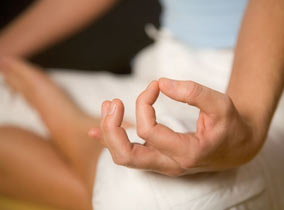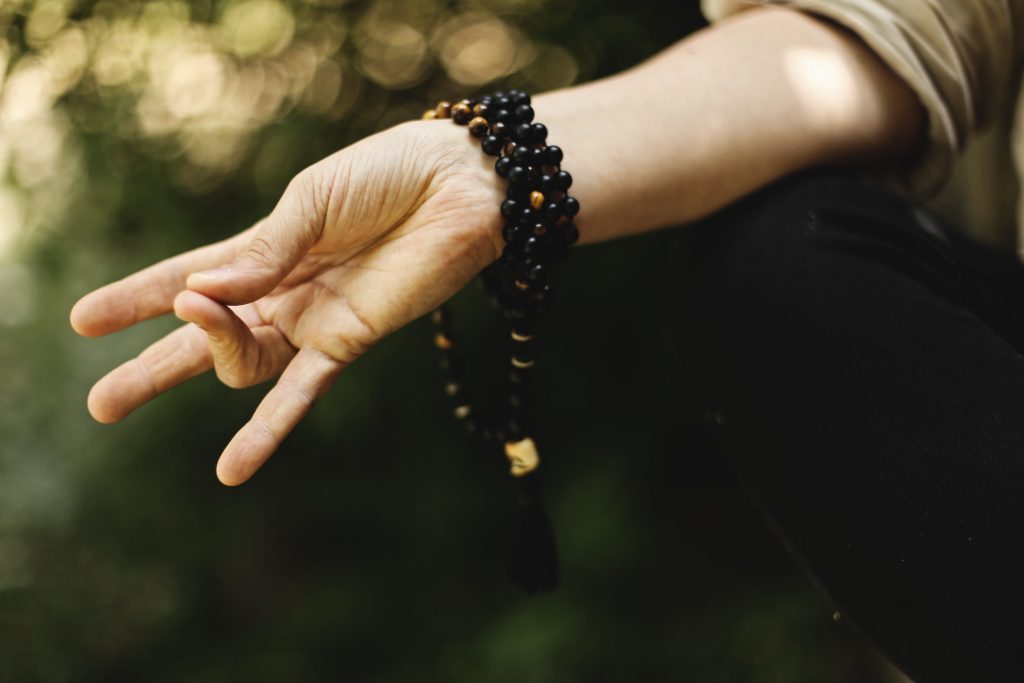As you become more familiar with meditation, you may want to consider adding certain hand gestures, or mudras, to your practice. Mudras aren’t just symbols with no practical uses. Meditation, yoga and energy work practitioners believe that mudras help to complete the energy circuit inside us and allow our life force to stay within the body, instead of escaping through the tips of our fingers during meditation and yoga exercises. By adopting a certain meditative or yoga pose and then sealing it with our hands, we help to preserve and cultivate our life force, or qi.
Check out this introduction to mudras by Eclectic Energies:
Mudras are positions of the body that have some kind of influence on the energies of the body, or your mood. Mostly the hands and fingers are held in some position, but the whole body may be part of the mudra as well.
 The most well-known mudras are probably the ones performed while meditating. One sits in lotus position (or with crossed legs) and either puts one’s hands on the knees, the tips of the thumb and index finger joining, or in the lap, the fingers of the right hand resting on the left palm. But also the christian crossing of the fingers for prayer is a mudra, as is the “Namaste” indian greeting gesture (that is also used while praying), where the hands are held in front of the chest, the palms touching.
The most well-known mudras are probably the ones performed while meditating. One sits in lotus position (or with crossed legs) and either puts one’s hands on the knees, the tips of the thumb and index finger joining, or in the lap, the fingers of the right hand resting on the left palm. But also the christian crossing of the fingers for prayer is a mudra, as is the “Namaste” indian greeting gesture (that is also used while praying), where the hands are held in front of the chest, the palms touching.
The crossing of the hands puts one’s attention within, while opening the heart. The indian greeting gesture puts one into a mood of respect.
Some mudras are performed spontaneously by many people, like the Hakini mudra, where the tips of all fingers from the right hand touch the corresponding fingertips from the left.
Mudras have been in use in the East for thousands of years, particularly in Buddhism. Buddha statues often have the hands in certain hand positions. They have been used as a spiritual practice (and still are), as a way on the path to enlightenment. However they’re also used for physical ailments.
Using Mudras
To use a mudra, keep it for at least a couple of minutes. It is usually more effective to do them a while longer, like 15 minutes or so. You might spread that time over the day, but you could also make it part of meditation.
Hold the finger-positions with both hands, at the same time. This will have a more powerful effect than doing a mudra with just one hand.
Some mudras are simple enough so that you can even do them with your hands in your pockets. You can do these anywhere when you feel you need them, without attracting attention.
Read the original article here.
Do you want to try adding mudras to your meditation practice? Check out these tips from The Conscious Life:
Ideally, mudras should be combined with the right pose, mind and intention to unleash their potential. For example, if you are using mudras with breathing meditation, adopt the proper sitting position (which means neutral back and relaxed shoulders) and turn your attention to your inhales and exhales. Be mindful of distracting thoughts. Gently leave them behind and bring yourself back to your breathing whenever they rise to the top of your mind. Keep your mind uncluttered, calm and peaceful as much as you can.
You don’t have to stick to the same mudra in every sitting. Match mudras to your changing needs to create meditation sessions that work for you. Having said that, note that it usually takes some time practicing with a particular mudra to appreciate its subtle effect on your energies. Be patient, take your time.
Click here to read more.
Ready to get started? If you want to read more, we recommend reading Mudras: Yoga in Your Hands, by Gertrud Hirschi. This book shows you how mudra techniques can prevent illness, relieve stress, and heal emotional problems, and contains helpful illustrations of mudras.



